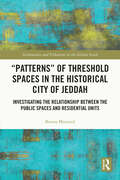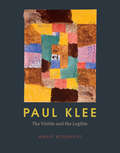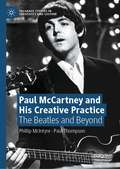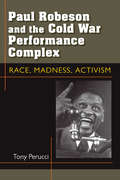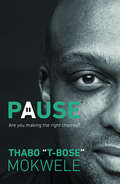- Table View
- List View
“Patterns” of Threshold Spaces in the Historical City of Jeddah: Investigating the Relationship Between the Public Spaces and Residential Units (Architecture and Urbanism in the Global South)
by Basma Massoud“Patterns” of Threshold Spaces in the Historical City of Jeddah explores the meaning of threshold spaces and investigates the relationship between the public spaces and residential units in the historical city of Jeddah, Saudi Arabia, while at the same time revisiting Christopher Alexander’s theory in his canonical 1977 book, A Pattern Language. This book questions and analyses “patterns” relating to the cultural, social, and environmental particularities of Jeddah, with special attention paid to the effect of gender segregation in the city’s urban configuration. It discusses the extension that has been undertaken through testing a concept from the urban design theory of the West (the United States and Canada) and applying it to an Islamic city to find patterns in four different scales, which form the basis of the investigation (body, building, street, and city). Empirical methods have been used in the context of historical Jeddah, through which patterns are investigated using different approaches for the different scales. The book aims to explore the meaning of threshold spaces in old Jeddah. Furthermore, it shows that there are eighteen patterns of threshold spaces in the old town: patterns that are solely related to this specific case study, as well as modified patterns to the ones explored by Christopher Alexander. This book shall allow not only a better understanding of the relationship between housing and the historical city but also an exploration of the role of the threshold space in shaping the old city of Jeddah. It will be of interest to researchers, students of architecture, urban planning and anthropology studies, and people involved in cultural heritage, both academics and practitioners.
“Patterns” of Threshold Spaces in the Historical City of Jeddah: Investigating the Relationship Between the Public Spaces and Residential Units (Architecture and Urbanism in the Global South)
by Basma Massoud“Patterns” of Threshold Spaces in the Historical City of Jeddah explores the meaning of threshold spaces and investigates the relationship between the public spaces and residential units in the historical city of Jeddah, Saudi Arabia, while at the same time revisiting Christopher Alexander’s theory in his canonical 1977 book, A Pattern Language. This book questions and analyses “patterns” relating to the cultural, social, and environmental particularities of Jeddah, with special attention paid to the effect of gender segregation in the city’s urban configuration. It discusses the extension that has been undertaken through testing a concept from the urban design theory of the West (the United States and Canada) and applying it to an Islamic city to find patterns in four different scales, which form the basis of the investigation (body, building, street, and city). Empirical methods have been used in the context of historical Jeddah, through which patterns are investigated using different approaches for the different scales. The book aims to explore the meaning of threshold spaces in old Jeddah. Furthermore, it shows that there are eighteen patterns of threshold spaces in the old town: patterns that are solely related to this specific case study, as well as modified patterns to the ones explored by Christopher Alexander. This book shall allow not only a better understanding of the relationship between housing and the historical city but also an exploration of the role of the threshold space in shaping the old city of Jeddah. It will be of interest to researchers, students of architecture, urban planning and anthropology studies, and people involved in cultural heritage, both academics and practitioners.
Patty Lyons' Knitting Bag of Tricks: Over 70 sanity saving hacks for better knitting
by Patty LyonsDo you wish your knitting was better and that you had an expert knitter by your side to help you when it goes wrong? Then this is the book for you. Patty Lyons is an expert in all things knitting related. She will help you solve all of your knitting problems—from edges that won’t behave to adjusting your yarn tension—with the 70+ hacks in Patty Lyons’ Knitting Bag of Tricks. Featuring dozens of brand new how-tos and the most popular tricks from author Patty Lyons’ beloved advice columns, this handy guide goes far beyond your typical knitting tips. Knitters of all levels will discover both why and how various techniques work, and improve both the look of their knitting and their command of stitches. It’s sure to take any knitter’s skills up to the next level. With more than 30K followers on social media and name-checks by everyone from the Wall Street Journal to popular television show, Late Night with Seth Meyers, Patty is a well-known name in the knitting community. This isn’t like other ‘how to knit’ books with basic information about casting on and how to form stitches (although there is a handy how-to reference section at the back for when you need a refresher), this is a book about the ‘why’ of knitting. Not about ‘why we knit’ but about ‘why we knit the way we do’. By digging deeper into the ‘why’ Patty doesn’t just fix your knitting problems she helps you to truly understand why the yarn/stitches/needles/tension are acting in a certain way and how to fix any issues. She starts by looking at the basics and explores the anatomy of a stitch, examining how this affects the look, feel and shape of the finished knitted fabrics and how different knitting techniques affect the finished outcome. Patty examines the problems caused by common mistakes that many knitters make without even noticing before diving into more complex knitting issues and how to trouble shoot them. All of Patty’s techniques and tips are illustrated with detailed step-by-step artworks for absolute clarity. And, as you’d expect from a Patty Lyons book, there is a healthy scattering of humor and irreverence throughout – you might take knitting seriously but you don’t have to be serious while knitting!
Paul Cézanne (Great Artists)
by Jane BinghamIn the words of Matisse and Picasso, Paul Cézanne was the 'father of us all', his approach to color and perspective paving the way for later modernist art movements such as Cubism and Expressionism, as he moved beyond the figurative tradition and towards abstraction. This book charts Cézanne's journey as an artist, his involvement with the Impressionist movement and his importance as a leading Post-Impressionist. It explores the places where he lived and worked, his personal life and friendships, and the artistic influences that helped to shape his remarkable vision of the world. This biographical detail is set alongside a selection of his brilliant paintings, allowing you to trace the evolution of his artwork. ABOUT THE SERIES: The Great Artists series by Arcturus Publishing introduces some of the most significant artists of the past 150 years, looking at their lives, techniques and inspirations, as well as presenting a selection of their best work.
Paul Cézanne (Great Artists of the World #1)
by Alix WoodGreat Artists introduces young readers to some of the world's great artists. The books feature easy-to-read text and some of the most famous examples of each artist's work, as well as photographs of places and people of importance.
Paul Delaroche: Painting and Popular Spectacle
by Patricia SmythPaul Delaroche: Painting and Popular Spectacle explores the connections between painting and an emergent popular visual culture in the early nineteenth century, which included new forms of optical entertainment such as Panoramas and Dioramas and innovation in fields such as illustration, art reproduction, and stage decor. Delaroche’s paintings caused a sensation at the Paris Salon, with critics comparing the emotional response they elicited to that of popular melodrama. Yet his appeal to a certain type of spectator lay behind the increasingly hostile criticism to which his works were subjected, and has in our own time led to his uncertain status in the art historical canon. This book focuses on Delaroche’s popularity with a newly expanded audience. Lacking in specialist knowledge, but nevertheless keen to engage with and deeply affected by art, the behaviour of this new public prompted lively discussions about who has the right to judge art and on whatgrounds.Working across disciplinary boundaries, this book proposes a new reading both of Delaroche and of the connections between the arts in this period. The artist emerges as a figure at the cutting edge of an emergent trans-medial popular visual culture in which we see the formation of modern spectatorship.
Paul Klee: The Visible and the Legible
by Annie BourneufThe fact that Paul Klee (1879–1940) consistently intertwined the visual and the verbal in his art has long fascinated commentators from Walter Benjamin to Michel Foucault. However, the questions it prompts have never been satisfactorily answered—until now. In Paul Klee, Annie Bourneuf offers the first full account of the interplay between the visible and the legible in Klee’s works from the 1910s and 1920s. Bourneuf argues that Klee joined these elements to invite a manner of viewing that would unfold in time, a process analogous to reading. From his elaborate titles to the small scale he favored to his metaphoric play with materials, Klee created forms that hover between the pictorial and the written. Through his unique approach, he subverted forms of modernist painting that were generally seen to threaten slow, contemplative viewing. Tracing the fraught relations among seeing, reading, and imagining in the early twentieth century, Bourneuf shows how Klee reconceptualized abstraction at a key moment in its development.
Paul Klee: The Visible and the Legible
by Annie BourneufThe fact that Paul Klee (1879–1940) consistently intertwined the visual and the verbal in his art has long fascinated commentators from Walter Benjamin to Michel Foucault. However, the questions it prompts have never been satisfactorily answered—until now. In Paul Klee, Annie Bourneuf offers the first full account of the interplay between the visible and the legible in Klee’s works from the 1910s and 1920s. Bourneuf argues that Klee joined these elements to invite a manner of viewing that would unfold in time, a process analogous to reading. From his elaborate titles to the small scale he favored to his metaphoric play with materials, Klee created forms that hover between the pictorial and the written. Through his unique approach, he subverted forms of modernist painting that were generally seen to threaten slow, contemplative viewing. Tracing the fraught relations among seeing, reading, and imagining in the early twentieth century, Bourneuf shows how Klee reconceptualized abstraction at a key moment in its development.
Paul Klee: The Visible and the Legible
by Annie BourneufThe fact that Paul Klee (1879–1940) consistently intertwined the visual and the verbal in his art has long fascinated commentators from Walter Benjamin to Michel Foucault. However, the questions it prompts have never been satisfactorily answered—until now. In Paul Klee, Annie Bourneuf offers the first full account of the interplay between the visible and the legible in Klee’s works from the 1910s and 1920s. Bourneuf argues that Klee joined these elements to invite a manner of viewing that would unfold in time, a process analogous to reading. From his elaborate titles to the small scale he favored to his metaphoric play with materials, Klee created forms that hover between the pictorial and the written. Through his unique approach, he subverted forms of modernist painting that were generally seen to threaten slow, contemplative viewing. Tracing the fraught relations among seeing, reading, and imagining in the early twentieth century, Bourneuf shows how Klee reconceptualized abstraction at a key moment in its development.
Paul Klee: The Visible and the Legible
by Annie BourneufThe fact that Paul Klee (1879–1940) consistently intertwined the visual and the verbal in his art has long fascinated commentators from Walter Benjamin to Michel Foucault. However, the questions it prompts have never been satisfactorily answered—until now. In Paul Klee, Annie Bourneuf offers the first full account of the interplay between the visible and the legible in Klee’s works from the 1910s and 1920s. Bourneuf argues that Klee joined these elements to invite a manner of viewing that would unfold in time, a process analogous to reading. From his elaborate titles to the small scale he favored to his metaphoric play with materials, Klee created forms that hover between the pictorial and the written. Through his unique approach, he subverted forms of modernist painting that were generally seen to threaten slow, contemplative viewing. Tracing the fraught relations among seeing, reading, and imagining in the early twentieth century, Bourneuf shows how Klee reconceptualized abstraction at a key moment in its development.
Paul McCartney and His Creative Practice: The Beatles and Beyond (Palgrave Studies in Creativity and Culture)
by Phillip McIntyre Paul ThompsonThis book provides fresh insight into the creative practice developed by Paul McCartney over his extended career as a songwriter, record producer and performing musician. It frames its examination of McCartney’s work through the lens of the systems model of creativity developed by Mihaly Csikszentmihalyi and combines this with the research work of Pierre Bourdieu. This systems approach is built around the basic structures of idiosyncratic agents, like McCartney himself, and the choices he has made as a creative individual. It also locates his work within social fields and cultural domains, all crucial aspects of the creative system that McCartney continues to be immersed in. Using this tripartite system, the book includes analysis of McCartney’s creative collaborations with musicians, producers, artists and filmmakers and provides a critical analysis of the Romantic myth which forms a central tenet of popular music. This engaging work will have interdisciplinary appeal to students and scholars of the psychology of creativity, popular music, sociology and cultural studies.
Paul Robeson and the Cold War Performance Complex: Race, Madness, Activism (Theater: Theory/Text/Performance)
by Tony PerucciActor and singer Paul Robeson's performances in Othello, Show Boat, and The Emperor Jones made him famous, but his midcentury appearances in support of causes ranging from labor and civil rights to antilynching and American warmongering made him notorious. When Robeson announced at the 1949 Paris Peace Conference that it was "unthinkable" for blacks to go to war against the Soviet Union, the mainstream American press declared him insane. Notions of Communism, blackness, and insanity were interchangeably deployed during the Cold War to discount activism such as Robeson's, just a part of an array of social and cultural practices that author Tony Perucci calls the Cold War performance complex. Focusing on two key Robeson performances---the concerts in Peekskill, New York, in 1949 and his appearance before the House Committee on Un-American Activities in 1956---Perucci demonstrates how these performances and the government's response to them are central to understanding the history of Cold War culture in the United States. His book provides a transformative new perspective on how the struggle over the politics of performance in the 1950s was also a domestic struggle over freedom and equality. The book closely examines both of these performance events as well as artifacts from Cold War culture---including congressional documents, FBI files, foreign policy papers, the popular literature on mental illness, and government propaganda films---to study the operation of power and activism in American Cold War culture.
Paula Rego's Map of Memory: National and Sexual Politics
by Maria Manuel LisboaThis title was first published in 2003. The artist Paula Rego was born in Portugal but has lived in Britain since 1951. In this well-illustrated book, Maria Manuel Lisboa explores the background behind Rego's decision to leave the land of her birth and, in doing so, provides fascinating insights into Rego's persistent portrayal of uneasy and predatory relations between men and women. Looking back over the national, religious and sexual politics of Portugal during Rego's childhood under the shadow of the Salazar dictatorship and subsequently, Lisboa locates the origins of the artist's preoccupation with power and powerlessness, violence and abuse within the political and ideological status quo of Portugal, past and present. The author's clear and thoughtful analysis offers an ambitious contribution to the study of patriarchy, Catholicism and Fascism and their expression in the work of this artist.
Paula Rego's Map of Memory: National and Sexual Politics
by Maria Manuel LisboaThis title was first published in 2003. The artist Paula Rego was born in Portugal but has lived in Britain since 1951. In this well-illustrated book, Maria Manuel Lisboa explores the background behind Rego's decision to leave the land of her birth and, in doing so, provides fascinating insights into Rego's persistent portrayal of uneasy and predatory relations between men and women. Looking back over the national, religious and sexual politics of Portugal during Rego's childhood under the shadow of the Salazar dictatorship and subsequently, Lisboa locates the origins of the artist's preoccupation with power and powerlessness, violence and abuse within the political and ideological status quo of Portugal, past and present. The author's clear and thoughtful analysis offers an ambitious contribution to the study of patriarchy, Catholicism and Fascism and their expression in the work of this artist.
Paula Vogel (Michigan Modern Dramatists)
by Joanna MansbridgePaula Vogel’s plays, including the Pulitzer–prizewinning How I Learned to Drive, initiate a conversation with contemporary culture, staging vexed issues like domestic violence, pornography, and AIDS. She does not write "about" these concerns, but instead examines how they have become framed as “issues”–as sensationalized topics–focusing on the histories and discourses that have defined them and the bodies that bear their meanings. Mobilizing campy humor, keen insight, and nonlinear structure, her plays defamiliarize the identities and issues that have been fixed as "just the way things are." Vogel crafts collage-like playworlds that are comprised of fragments of history and culture, and that are simultaneously inclusive and alienating, familiar and strange, funny and disturbing. At the center of these playworlds are female characters negotiating with the images and discourses that circumscribe their lives and bodies. In this, the first book-length study of Vogel and her work, Joanna Mansbridge explores how Vogel’s plays speak back to the canon, responding to and rewriting works by William Shakespeare, Edward Albee, Sam Shepard, and David Mamet, rearranging their plots, revising their conflicts, and recasting their dramatis personae. The book examines the theories shaping the playwright and her plays, the production and reception of her work, and the aesthetic structure of each play, grounding the work in cultural materialist, feminist and queer theory, and theater and performance studies scholarship.
Pause: Are you making the right choices?
by Thabo T-Bose MokweleWhen we learn from each other, that’s when we learn more about ourselves.With a radio career spanning more than three decades, Thabo T-Bose Mokwele brings topics to the airwaves that challenge and invoke human introspection and dialogue with his audience. And through this he has learned a lot about life and its nuances. Pause is a collection of Thabo’s observations, reflections and learnings about what life is about. Simply put, this is the book he wishes he had read before starting his adult life journey.Pause is a compilation of Thabo's pearls of wisdom and lessons about life, God, money, relationships, parenting and, most importantly, self-mastery. His knowledge has been acquired by reading other philosophers' views on life and love, from interviewing entrepreneurs and entertainers about self-sufficiency, and preachers and teachers about self-mastery. This, you may say, is his ‘bible’, to drive his life, and a lens through which he views his existence.Thabo shares what he knows, what he practises and what still challenges him. It’s a book that everyone, from teens to adults, should read for a glimpse, and as a guide, to living a life that is meaningful.We learn from our mistakes, but some mistakes are costly and should never be repeated. And if reading a short chapter on a particular topic can help mould a young person’s life, or assist an adult to self-correct, then Pause is a must-read.Thabo says: We all need to learn, unlearn and relearn many things in order to fully realise who we are meant to be.
Pavement Materials and Associated Geotechnical Aspects of Civil Infrastructures: Proceedings of the 5th GeoChina International Conference 2018 – Civil Infrastructures Confronting Severe Weathers and Climate Changes: From Failure to Sustainability, held on July 23 to 25, 2018 in HangZhou, China (Sustainable Civil Infrastructures)
by WJvdM Steyn Irina Holleran BooHyun NamThis book contains latest research studies regarding issues related to civil infrastructure such as pavement layers and material properties. It contains research data and conclusions that should lead to more resilient infrastructure design, maintenance and management. Civil engineering researchers and practitioners will gain valuable information from this material. Papers were selected from the 5th GeoChina International Conference on Civil Infrastructures Confronting Severe Weathers and Climate Changes: From Failure to Sustainability, held on July 23-25, 2018 in HangZhou, China.
Pavilions, Pop Ups and Parasols: The Impact of Real and Virtual Meeting on Physical Space (Architectural Design)
by Leon Van Schaik Fleur WatsonAround the world, a new architectural form is emerging. In public places a progressive architecture is being commissioned to promote open-ended, undetermined, lightly programmed or un-programmed interactions between people. This new phenomenon of architectural form – Pavilions, Pop-Ups and Parasols – is presaged by rapidly changing social relationships flowing from social media such as Facebook, Twitter and Instagram. The nexus between real and virtual meeting is effectively being reinvented by innovative and creative architectural practices. People meet in new and responsive ways, architects meet their clients in new forums, knowledge is ‘met’ and achieved in new and interactive frameworks. It contrasts bluntly with the commercially structured interactions of shopping malls and the increasingly deliberate interactions available in cultural institutions. These experiences imbue a new type of client; casually engaged, flocking, hacking, crowd funding and self-helping. Contributors include: Rob Bevan, Pia Ednie-Brown, Roan Ching-Yueh, Dan Hill, Martyn Hook, Minsuk Cho, Andrea Kahn, Felicity Scott, Akira Suzuki Contributing architects include: Alisa Andrasek/Biothing, Peter Cook/CRAB studio, CJ Lim/Studio 8, Tom Holbrook/5th Studio, Matthias Hollwich/HWKN, Mamou-Mani Architects, Benedetta Tagliabue/EMBT
Pay for Your Pleasures: Mike Kelley, Paul McCarthy, Raymond Pettibon
by Cary LevineMike Kelley, Paul McCarthy, and Raymond Pettibon—these Southern California artists formed a “bad boy” trifecta. Early purveyors of abject art, the trio produced work ranging from sculptures of feces to copulating stuffed animals, and gained notoriety from being perverse. Showing how their work rethinks transgressive art practices in the wake of the 1960s, Pay for Your Pleasures argues that their collaborations as well as their individual enterprises make them among the most compelling artists in the Los Angeles area in recent years. Cary Levine focuses on Kelley’s, McCarthy’s, and Pettibon’s work from the 1970s through the 1990s, plotting the circuitous routes they took in their artistic development. Drawing on extensive interviews with each artist, he identifies the diverse forces that had a crucial bearing on their development—such as McCarthy’s experiences at the University of Utah, Kelley’s interest in the Detroit-based White Panther movement, Pettibon’s study of economics, and how all three participated in burgeoning subcultural music scenes. Levine discovers a common political strategy underlying their art that critiques both nostalgia for the 1960s counterculture and Reagan-era conservatism. He shows how this strategy led each artist to create strange and unseemly images that test the limits of not only art but also gender roles, sex, acceptable behavior, poor taste, and even the gag reflex that separates pleasure from disgust. As a result, their work places viewers in uncomfortable situations that challenge them to reassess their own values. The first substantial analysis of Kelley, McCarthy, and Pettibon, Pay for Your Pleasures shines new light on three artists whose work continues to resonate in the world of art and politics.
Pay for Your Pleasures: Mike Kelley, Paul McCarthy, Raymond Pettibon
by Cary LevineMike Kelley, Paul McCarthy, and Raymond Pettibon—these Southern California artists formed a “bad boy” trifecta. Early purveyors of abject art, the trio produced work ranging from sculptures of feces to copulating stuffed animals, and gained notoriety from being perverse. Showing how their work rethinks transgressive art practices in the wake of the 1960s, Pay for Your Pleasures argues that their collaborations as well as their individual enterprises make them among the most compelling artists in the Los Angeles area in recent years. Cary Levine focuses on Kelley’s, McCarthy’s, and Pettibon’s work from the 1970s through the 1990s, plotting the circuitous routes they took in their artistic development. Drawing on extensive interviews with each artist, he identifies the diverse forces that had a crucial bearing on their development—such as McCarthy’s experiences at the University of Utah, Kelley’s interest in the Detroit-based White Panther movement, Pettibon’s study of economics, and how all three participated in burgeoning subcultural music scenes. Levine discovers a common political strategy underlying their art that critiques both nostalgia for the 1960s counterculture and Reagan-era conservatism. He shows how this strategy led each artist to create strange and unseemly images that test the limits of not only art but also gender roles, sex, acceptable behavior, poor taste, and even the gag reflex that separates pleasure from disgust. As a result, their work places viewers in uncomfortable situations that challenge them to reassess their own values. The first substantial analysis of Kelley, McCarthy, and Pettibon, Pay for Your Pleasures shines new light on three artists whose work continues to resonate in the world of art and politics.
PC Wars: Politics and Theory in the Academy
by Jeffrey WilliamsFirst Published in 1995. Routledge is an imprint of Taylor & Francis, an informa company.
PC Wars: Politics and Theory in the Academy
by Jeffrey WilliamsFirst Published in 1995. Routledge is an imprint of Taylor & Francis, an informa company.
PCM-Based Building Envelope Systems: Innovative Energy Solutions for Passive Design (Green Energy and Technology)
by Benjamin DurakovićPCM Enhanced Building Envelopes presents the latest research in the field of thermal energy storage technologies that can be applied to solar heating and cooling with the aim of shifting and reducing building energy demand. It discusses both practical and technical issues, as well as the advantages of using common phase change materials (PCMs) in buildings as a more efficient, novel solution for passive solar heating/cooling strategies. The book includes qualitative and quantitative descriptions of the science, technology and practices of PCM-based building envelopes, and reflects recent trends by placing emphasis on energy storage solutions within building walls, floors, ceilings, façades, windows, and shading devices. With the aim of assessing buildings’ energy performance, the book provides advanced modeling and simulation tools as a theoretical basis for the analysis of PCM-based building envelopes in terms of heat storage and transfer. This book will be of interest to all those dealing with building energy analysis such as researchers, academics, students and professionals in the fields of mechanical and civil engineering and architectural design
PCM-Enhanced Building Components: An Application of Phase Change Materials in Building Envelopes and Internal Structures (Engineering Materials and Processes)
by Jan KośnyPresenting an overview of the use of Phase Change Materials (PCMs) within buildings, this book discusses the performance of PCM-enhanced building envelopes. It reviews the most common PCMs suitable for building applications, and discusses PCM encapsulation and packaging methods. In addition to this, it examines a range of PCM-enhanced building products in the process of development as well as examples of whole-building-scale field demonstrations. Further chapters discuss experimental and theoretical analyses (including available software) to determine dynamic thermal and energy performance characteristics of building enclosure components containing PCMs, and present different laboratory and field testing methods. Finally, a wide range of PCM building products are presented which are commercially available worldwide. This book is intended for students and researchers of mechanical, architectural and civil engineering and postgraduate students of energy analysis, dynamic design of building structures, and dynamic testing procedures. It also provides a useful resource for professionals involved in architectural and mechanical-civil engineering design, thermal testing and PCM manufacturing.
PDE and Level Sets: Algorithmic Approaches to Static and Motion Imagery (Topics in Biomedical Engineering)
by Swamy LaxminarayanPDE & Level Sets: Algorithmic Approaches to Static & Motion Imagery is specially dedicated to the segmentation of complex shapes from the field of imaging sciences using level sets and PDEs. It covers the fundamentals of level sets, different kinds of concepts of both geodesic curvature flows and planar flows, as well as the power of incorporation of regional-statistics in level set framework. In covering this material, this book presents segmentation of object-in-motion imagery based on level sets in eigen analysis framework, while also presenting classical problems of boundary completion in cognitive images, like the pop-up of subjective contours in the famous triangle of Kanizsa using surface evolution framework, or the mean curvature evolution of a graph with respect to the Riemannian metric induced by the image. All results are presented for modal completion of cognitive objects with missing boundaries.
